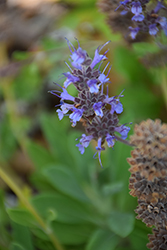It's all about ...
plants

Plant Height: 18 inches
Flower Height: 24 inches
Spacing: 3 feet
Sunlight:
![]()
![]()
Hardiness Zone: (annual)
Description:
A lovely, vibrant groundcover sage, producing low mounds of dense, dark green foliage; lavender-blue flowers, arranged in whorls on dainty spikes, rise up in spring to summer; fast growing, adaptable, and drought tolerant once established
Ornamental Features
Dara's Choice Sage has masses of beautiful spikes of lightly-scented lavender flowers with blue overtones and burgundy calyces rising above the foliage from early to late spring, which are most effective when planted in groupings. The flowers are excellent for cutting. Its attractive fragrant narrow leaves remain bluish-green in colour with curious white undersides throughout the season. The dark red stems can be quite attractive.
Landscape Attributes
Dara's Choice Sage is an herbaceous annual with a ground-hugging habit of growth. Its relatively fine texture sets it apart from other garden plants with less refined foliage.
This is a relatively low maintenance plant, and should only be pruned after flowering to avoid removing any of the current season's flowers. It is a good choice for attracting bees and hummingbirds to your yard, but is not particularly attractive to deer who tend to leave it alone in favor of tastier treats. It has no significant negative characteristics.
Dara's Choice Sage is recommended for the following landscape applications;
- Mass Planting
- Border Edging
- General Garden Use
- Groundcover
- Naturalizing And Woodland Gardens
- Container Planting
Planting & Growing
Dara's Choice Sage will grow to be about 18 inches tall at maturity extending to 24 inches tall with the flowers, with a spread of 4 feet. When grown in masses or used as a bedding plant, individual plants should be spaced approximately 3 feet apart. Its foliage tends to remain dense right to the ground, not requiring facer plants in front. Although it's not a true annual, this fast-growing plant can be expected to behave as an annual in our climate if left outdoors over the winter, usually needing replacement the following year. As such, gardeners should take into consideration that it will perform differently than it would in its native habitat.
This plant does best in full sun to partial shade. It is very adaptable to both dry and moist locations, and should do just fine under typical garden conditions. It is considered to be drought-tolerant, and thus makes an ideal choice for a low-water garden or xeriscape application. This plant should not require much in the way of fertilizing once established, although it may appreciate a shot of general-purpose fertilizer from time to time early in the growing season. It is not particular as to soil type or pH, and is able to handle environmental salt. It is highly tolerant of urban pollution and will even thrive in inner city environments. This particular variety is an interspecific hybrid. It can be propagated by division; however, as a cultivated variety, be aware that it may be subject to certain restrictions or prohibitions on propagation.
Dara's Choice Sage is a fine choice for the garden, but it is also a good selection for planting in outdoor pots and containers. Because of its spreading habit of growth, it is ideally suited for use as a 'spiller' in the 'spiller-thriller-filler' container combination; plant it near the edges where it can spill gracefully over the pot. Note that when growing plants in outdoor containers and baskets, they may require more frequent waterings than they would in the yard or garden.
